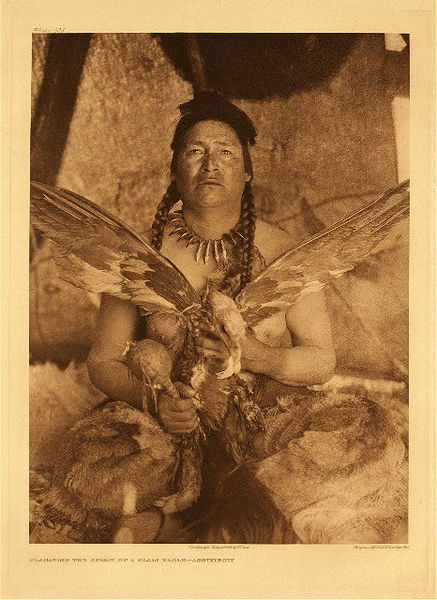Edward S. Curtis (1868-1952)
View Artist Biography
Title:
*50% OFF OPPORTUNITY* Plate 634 Placating the Spirit of a Slain Eagle - Assiniboin
Date:
1926
Size:
Portfolio: 22 x 18 inches
Medium:
Vintage Photogravure
This middle aged Assiniboin Man holds the spread winged carcass of an eagle. Eagles were coveted for their feathers which were used in many ways. Some of these uses include ornaments and fetishes. Once caught, the sacred eagle was honored by an elaborate ceremony that took place to placate the eagle’s spirit. In this image the man is participating in this ceremony.
The subject is likely the one who has slain the eagle. He wears a necklace made of claws and two long braids. He also carries some accoutrement to assist in the ceremony. This picture was taken by Edward Curtis in 1926 and is on display in our Aspen Art Gallery.
“Maintaining respectful, reciprocal relationships with slain animals was vital to the everyday lives of native peoples because the ability to connect with the spirit world was important.
“The path to power provided several options. Working alone, individuals might perform a vision quest, make tobacco offerings, or sing special songs to spirits of the animal and fish. After killing an animal, the hunter respectfully thanked its spirit for the sacrifice and tried to treat its body with respect.”
Edward Curtis recognized the immense value in the word “respect” within the pages of The North American Indian, and the photogravure portraits. Any cultural information in the pages of his volumes was obtained with permission of the tribes he wrote about.
The subject is likely the one who has slain the eagle. He wears a necklace made of claws and two long braids. He also carries some accoutrement to assist in the ceremony. This picture was taken by Edward Curtis in 1926 and is on display in our Aspen Art Gallery.
“Maintaining respectful, reciprocal relationships with slain animals was vital to the everyday lives of native peoples because the ability to connect with the spirit world was important.
“The path to power provided several options. Working alone, individuals might perform a vision quest, make tobacco offerings, or sing special songs to spirits of the animal and fish. After killing an animal, the hunter respectfully thanked its spirit for the sacrifice and tried to treat its body with respect.”
Edward Curtis recognized the immense value in the word “respect” within the pages of The North American Indian, and the photogravure portraits. Any cultural information in the pages of his volumes was obtained with permission of the tribes he wrote about.
